Buster Keaton: The Short Films Collection Blu-ray Movie
HomeBuster Keaton: The Short Films Collection Blu-ray Movie 
One Week / Convict 13 / Neighbors / The Scarecrow / The Haunted House / Hard Luck / The High Sign / The Goat / The Play House [Playhouse] / The Boat / The Paleface / Cops / My Wife's Relations / The Frozen North / The Electric House / Day Dreams [Daydreams] / The Balloonatic / The Love NestKino Lorber | 1920-1923 | 386 min | Not rated | Jul 12, 2011
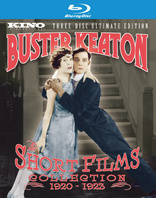
Movie rating
8.4 | / 10 |
Blu-ray rating
| Users | 3.8 | |
| Reviewer | 5.0 | |
| Overall | 4.4 |
Overview
Buster Keaton: The Short Films Collection (1920-1923)
Authorized by the Buster Keaton estate and mastered in HD from 35mm archival film elements, The Short Films Collection gathers all of Keaton’s solo silent comedies in one monumental three-disc set. Widely considered to be among Keaton’s finest work, the nineteen two-reel shorts are loaded with laughs, punctuated by breath-taking stunts, and bursting with raw creativity. Over the course of this three-year period, Keaton evolved from a successful slapstick comedian into one of cinema’s most inventive visual stylists, and became an enduring icon of American popular culture.
Starring: Buster Keaton, Sybil Seely, Virginia Fox, Joe Roberts (I)Director: Buster Keaton, Edward F. Cline
| Short | Uncertain |
| Comedy | Uncertain |
| Action | Uncertain |
Specifications
Video
Video codec: MPEG-4 AVC
Video resolution: 1080p
Aspect ratio: 1.34:1
Original aspect ratio: 1.33:1
Audio
Music: LPCM 2.0 (48kHz, 16-bit)
Subtitles
None
Discs
50GB Blu-ray Disc
Three-disc set (3 BDs)
Playback
Region free
Review
Rating summary
| Movie | 5.0 | |
| Video | 4.5 | |
| Audio | 4.5 | |
| Extras | 3.5 | |
| Overall | 5.0 |
Buster Keaton: The Short Films Collection Blu-ray Movie Review
The birth of a genius.
Reviewed by Casey Broadwater July 17, 2011The story of how Joseph “Buster” Keaton got into moving pictures is worth repeating. Born into “The Three Keatons,” his parents’ vaudeville act— where, as a toddler, he earned his nickname for his ability to painlessly take a pratfall—Buster left the family trade in 1917, at 21, and set off for New York City to make it on his own. He quickly fell in with outsized silent film star Roscoe “Fatty” Arbuckle, a fan of the Three Keatons, who was shooting The Butcher Boy at the time. Visiting the set with an old family friend, Buster was unexpectedly invited to perform in a few scenes with Arbuckle and made his spur-of-the-moment film debut with a bit about a spilled bucketful of molasses. After wrapping for the day, Buster asked Arbuckle if he could borrow one of the movie cameras to get a feel for how it worked. At home, he disassembled it and put it back together, and when he showed up the next morning to give it back, he took a job as a gag man and actor for producer Joe Schenk and Arbuckle’s “Comique” comedy troupe. This was the beginning of a three-year apprenticeship that gave Keaton ample opportunity to learn the ins and outs of working in front of and behind the camera. Impressed by his work, Schenk gave Keaton his own production unit, and between 1920 and 1923, Buster made 19 two-reel shorts, experiments in comedic tone that found the newly established actor/director discovering his own brand of sophisticated slapstick. Kino International has gathered together all 19 of these short films in a three-disc, newly remastered in high definition collection that’s simply essential for anyone who loves silent cinema. Read on for a quick overview of each two-reeler.
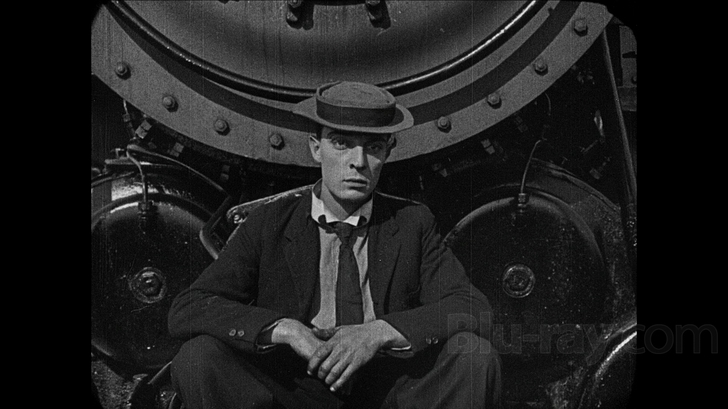
The Great Stone Face
The High Sign (1920/21, 19 min.)
Keaton's love of trains was well documented, so it seems appropriate that the first image in this set would be of him getting kicked off of one. As a bum in a new town, he grabs a newspaper to look at job postings—the paper comically unfolds to be the size of a bed sheet—and then applies for a gig at a shooting gallery that, unknowingly to him, is run by the notorious "Blinking Buzzard" gang. When Buster rigs up a contraption that rings a bell every time he fires a shot at the metal targets—here we see the genesis of his love of mechanical gags—everyone believes he's an expert rifleman. The leader of the Buzzards inducts him into the gang and gives him his first assignment, assassinating the town miser, August Nickelnurser. The twist, of course, is that Nicklenurser has also hired Buster to be his bodyguard. Hilarity ensues.
One Week (1920, 24 min.)
Keaton actually shot The High Sign first, but he chose One Week, a two-reeler on a much larger scale, as his debut film as writer/director/star. The scenario involves a newly married couple—Keaton and Sybil Seely—who are given a build-it-yourself house as a wedding gift. When a former admirer of Seely's sabotages the instructions for the house, Keaton ends up building a slanted, off-kilter home that has a kitchen sink on the outside and a front door on the second floor. There are two great gags here that prefigure ones Keaton would later expand upon for Steamboat Bill, Jr., including the facade of the house falling toward Buster, who narrowly fits through an open window, and a storm that sends the house spinning in circles. There's also a surprisingly sexy joke where Seely, in the bath, drops her soap outside the tub. When she goes to reach for it—which would expose her breasts—the cameraman reaches in front of the lens and covers it with his hand. These kind of self-referential, "hey, look, it's a movie" gags would become common in Keaton's cinema.
Convict 13 (1920, 19min.)
In Convict 13, Buster is out golfing when he accidentally knocks himself out ricocheting his ball off a barn, and while he's out cold a passing prison escapee swaps clothes with him. Dressed in stripes, Keaton gets picked up and hauled to the penitentiary, where he learns that "Convict 13"—the identity he's mistaken for—is scheduled to hang. When the noose is replaced with a bungee, there's a rather morbid sight gag that has Keaton bouncing up and down at the end of the cord. Somehow he ends up as assistant warden and quells a prisoner rebellion by swinging one of those iron balls—actually, a basketball, attached to a rope—in a wide arc, cold-cocking everyone who gets in his way.
The Scarecrow (1920, 18 min.)
"Big Joe" Roberts, one of Keaton's friends and regular collaborators, appears in sixteen of the nineteen short films in this collection. In The Scarecrow he gets a prominent role as Keaton's housemate and romantic rival, as both of them are vying for the attentions of the daughter (Sybil Seely) of the farmer for whom they work. The main gag here is that Keaton and Roberts have rigged up all sorts of crazy Rube Goldberg-like contraptions in their tiny one-room farmhouse in order to save space, from a tub that folds into the wall to salt and pepper shakers that hang from the ceiling by twine. The dinner scene is hilarious. Later, Keaton gets chased around by a vicious dog—played by "Fatty" Arbuckle's real-life pet, Luke —and ends up stealing a scarecrow's clothes when his own get ripped off in a wheat thresher. Watch closely for not-so-veiled references to prohibition and women’s suffrage!
Neighbors (1921, 19min.)
One of the more purely slapstick shorts in the collection, Neighbors features Keaton and Virginia Fox as young lovers whose parents' tenement houses are separated by a wooden fence through which the two get caught passing notes. Joe Roberts plays Virginia's father, and Buster's is played by his real-life dad, Joe Keaton. The two patriarch's hate each other and want to keep their children apart, but after much cartoonish comedy—Keaton using laundry lines as zip cords, getting stuck upside in the mud, and performing a few to-this-day amazing feats of acrobatics and balancing—Buster and Virginia are wedded. Naturally, the ceremony doesn't exactly go smoothly. Try to count how many times Keaton's pants fall down during the final scene.
The Haunted House (1080p, 1921, 20 min.)
Probably not one of Keaton's best, but definitely one of my personal favorites. Buster plays a bank teller who unwittingly gets involved with a gang of counterfeiters that uses an old mansion as a safe house. To keep the police and unwanted visitors out, they've gone to great lengths to make the place look haunted, installing a trick staircase and having a troupe of actors from a performance of Faust wander through the place, spooking any who dare to enter. Keaton gets trapped in this house of horrors, and the short culminates with our hero dreaming that he ascends to heaven only to slip rapidly down to hell. Look out for the creepy skeleton costumes, which had to have inspired Michel Gondry.
Hard Luck (1080p, 21 min.)
For over sixty years, Hard Luck was believed to be lost, but partially complete prints were eventually found and in 1987 the film was reassembled and restored from several elements. The rather scattershot plot involves Keaton as a down-and-out, jilted, and suicidal sad sack who regains his courage after chugging some whisky—thinking it's poison—and goes on several strange adventures, including a hunt for a rare armadillo. Unfortunately, the film's final gag—which Keaton considered one of his best—is still missing. In this long-lost scene, Keaton dives off a high dive and, missing the pool below, leaves a hole in the ground. After an intertitle reading "Years Later," Keaton emerges from the hole with a Chinese wife and children. Unfortunately, aside from a shot of Keaton climbing the high dive ladder, a shot of people looking down the hole, and a still photograph of Buster with his new Chinese family, the action of this scene is left entirely to our imaginations.
The Goat (1921, 23min.)
This one starts with a great bit where Buster goes to the end of a breadline but doesn't realize that he's actually waiting behind two stationary mannequins. He pulls out a pin and discretely pokes one of the mannequins in the backside and then, surprised by the lack of a reaction, pokes himself to see if the pin is sharp. And of course it is! Later, he gets mistaken for a murderer named "Dead Shot Dan," which sets off the kind of prolonged police chase plot Keaton would also use in Cops and Day Dreams. There's a beautifully iconic shot here that has Buster sitting on the front of a locomotive that speeds toward a camera sitting on the tracks, taking us into one of Keaton's characteristically deadpan close- ups. There’s a reason he was called “The Great Stone Face.”
The Play House (1921, 23 min.)
Perhaps Keaton's most complex undertaking yet, The Play House is a marvel of technical ingenuity. In the first half of this two-reeler, Buster attends a minstrel show where all the performer—the musicians in the orchestra pit and the dancers on stage—are all played by Keaton. Simultaneously. Keaton's go-to cameraman Elgin Lessley accomplished this feat by masking off part of the lens, shooting one take, rewinding the film, masking another section, and shooting again. At one point, we see nine Busters seamlessly interacting with one another at the same time. Somehow, the technical precision is upstaged by Keaton's hilarious performance. In the second act, we see Buster—really just a dreaming stagehand—being woken up by Big Joe Roberts and told to get to work. Tasked with dressing a chimpanzee for a show, he dolls himself up like a chimp instead and does what might very well be the best monkey impersonation ever committed to film.
The Boat (1921, 23 min.)
Man versus nature is a common theme in Keaton's films—see the hurricane in Steamboat Bill, Jr., or the river rapids scene in Our Hospitality—and this preoccupation is prefigured in The Boat, which features Buster, his wife (Sybil Seely), and their two flat-hat wearing kids sailing out onto the Pacific in their homemade vessel, The Damfino, which sinks in a massive storm. The boat's name is a double-layered pun; in one sense the boat is "damn fine," but the biggest laugh comes when Buster and his brood wash up on the shore of a distant island. "Where are we?" asks Sybil, and Buster, with no need for an intertitle, clearly mouths, "Damned if I know."
The Paleface (1922, 20 min.)
A semi-satirical western, The Paleface opens with an evil oil baron, intent on stealing indian land, sending an evacuation notice to a tribe led by Big Joe Roberts in ridiculous "brownface" make-up. The chief gives an order to his warriors: kill the first white man that comes into the village. It's Keaton, of course, playing an innocent insect hunter who wanders through the village gate following a butterfly. (At one point, frustrated with his inability to catch the fluttering bug, he tries, flailingly, to punch it out of the air.) Buster narrowly escapes being burnt at the stake—spoiler alert: he puts on asbestos underwear—and after a lengthy chase sequence ends up inducted into the tribe as "Little Chief Paleface." Many of Keaton's best gags involve playing against and with the audience's expectations, and there's a brilliant bit at the end where Buster leans in to plant a kiss on his new squaw bride. An intertitle pops up reading "Two Years Later," but when the image cuts back in, Buster is still smooching away.
Cops (1922, 18 min.)
The second, and best, of Keaton's police films, Cops concludes with a brilliantly executed five-minute chase sequence that involves hundreds of uniformed extras. Buster, of course, is drawn into this predicament rather haplessly when he goes into the big city to prove himself after his girlfriend tells him, "I won't marry you until you become a big business man." A grifter cons Buster into buying a cart full of household goods—which actually belong to an unsuspecting family—and our well-intentioned hero sets off on this wagon, pulled by the slowest horse imaginable. Things speed up considerably when Buster finds himself in the middle of a massive police parade and accidentally tosses an anarchist's bomb into the crowd of cops. The resultant chase is pure slapstick poetry, and the surprise ending is one of the bleakest punchlines Keaton ever delivered.
My Wife's Relations (1922, 17 min.)
Keaton's leading ladies were usually sweet, willowy types, but in My Wife's Relations, he's paired with the large-and-in-charge Kate Price, a burly well-known comedienne who came from a burlesque background. In "the foreign section of a big city," Keaton plays a taffy-maker who—in an unfortunate "lost in translation" mishap involving a judge who only speaks Polish—finds himself wedded to the portly, domineering Price. When Price takes Buster home to her equally chunky, blue collar family, the intertitle reads: "Daniel never entered a den like this." The rest of the film—which, unlike most of these shorts, takes place almost entirely indoors—is a restrained romp that deals largely in bad manners, especially "new money" behavior when Price's clan mistakenly comes to believe that Buster is exorbitantly rich.
The Blacksmith (1922, 21 min.)
Keaton called this one "that dud," and it is something of an uninspired step backward, reusing several old gags from Buster's apprentice days with Fatty Arbuckle. Keaton plays a town blacksmith who can't seem to do anything right, squirting oil all over both a gleaming white horse and a brand- new Rolls Royce. The short has its funny moments, though. Buster adopts the demeanor of a shoe store salesman when he tries to fit the horse with new shoes, and there's a clever twist ending that turns what appears to be a tragedy into a playfully sweet send-off.
The Frozen North (1922, 17 min.)
This is a rarity. You don't often see Buster Keaton portrayed as a "bad guy," but in The Frozen North he definitely seems morally suspect. Initially, at least. Buster lives in a town that's so far north the North Pole is "three miles south," and the film opens with him attempting to hold up a casino. (This doesn't go well.) Later, he bursts into a house that he thinks is his only to see a woman he thinks is his wife in the arms of another man. In a fit of passion he shoots them dead, only to quickly realize, "I've made a mistake. This isn't my house or my wife!" As if murder weren't enough, Keaton eschews his own wife (Sybil Seely) and brings flowers to his married neighbor (Bonnie Hill), spending the rest of the movie running from the woman's husband. This is not the Keaton we know or expect! But, spoiler alert: there's a surprise ending that makes it all okay.
Day Dreams (1922, 21 min.)
Keaton's third police chase movie is, in many ways, similar to its predecessor, Cops. In order to win the hand of the girl he admires, Buster once again heads into the big city to prove himself, promising her father that he'll shoot himself in the head if he fails. Buster sends back letters claiming that he's become a surgeon, then a Wall Street bigwig, and finally an actor playing Hamlet, but in reality he's found jobs as a janitor at a veterinarian's office, a street sweeper, and a clumsy chorus dancer in an off-Broadway follies show. When he inadvertently sets off another police chase, he ends up running in place hamster-style inside a riverboat's paddlewheel, an impressive stunt that has Buster doing somersaults and getting repeatedly flipped and dunked. If Keaton seems to be repeating himself here, it’s mostly because he was anxious to move on to feature films but was still contracted to deliver three more two-reelers. His last shorts—The Electric House, The Balloonatic, and The Love Nest—are not among his best, and while they each deliver some memorable gags, they seem to show his impatience with the constraints of the 20-minute format.
The Electric House (1922, 23 min)
Of his final three shorts before moving on to features with 1923's Three Ages, The Electric House is the best. When a millionaire (Big Joe Roberts) comes to a college graduation looking to hire someone to modernize his house with electric appliances, an accidental switcheroo of diplomas results in Buster, a botanist, getting the gig. While the millionaire is in Europe, Buster rigs up all kinds of Rube Goldberg-esque contraptions, from a toy train that serves dinner to a pool table that automatically sorts and racks the balls at the beginning of each game. The centerpiece of the house is an enormous escalator, which, naturally, goes haywire when the real electrician arrives to get revenge. A version of The Electric House was actually first filmed in 1920, but when Keaton broke his ankle doing a stunt on the escalator, the short was canned, only to be re- shot two years later when Keaton was looking for material to fulfill his contractual obligations.
The Balloonatic (1923, 22 min.)
The Balloonatic—yes, it rhymes with lunatic—may seem more like a collection of gags than a coherent whole, but at least the gags are good. We start at a carnival, where Buster goes on a Tunnel of Love-type ride with a young lady, only to emerge at the end with a black eye and broken hat, clearly the result of him trying to put the moves on her. Later, when he encounters a scientific expedition preparing to launch a hot air balloon, Buster is accidentally sent up-up-and-away, landing finally in the wilderness for several outdoorsy misadventures with a girl he soon meets. As almost-always, Keaton closes the short with a perfect image—the new couple floating across the sky in a canoe held aloft by Buster’s balloon.
The Love Nest (1923, 20 min.)
After his fiance breaks off their engagement, Buster begins The Love Nest by swearing off women forever. To clear his mind, he decides to go on a trip around the world in his tiny boat, Cupid. When he happens upon a whaling ship captained by Big Joe Roberts—as as cross between Ahab and Captain Blythe of Mutiny on the Bounty—Buster comes on board as the new cabin boy, a dangerous occupation considering the fact that Big Joe has killed off the last few sailors to hold the position. Aside from—once again—a perfect ending, this last two-reeler is the least memorable of the 19 he made rapidly between 1920 and 1923, but you can hardly blame Keaton for wanting to finish with shorts and get started on his first feature, as fellow silent comics Charlie Chaplin and Harold Lloyd had already beaten him to the punch. It wouldn't take him long to catch up. The mid-1920s were Keaton’s most creatively fertile period, and within the span of seven years he would make several films which can each be counted among the greatest comedies of all time, including Our Hospitality, Sherlock Jr., The General, and Steamboat Bill Jr.
Buster Keaton: The Short Films Collection Blu-ray Movie, Video Quality 
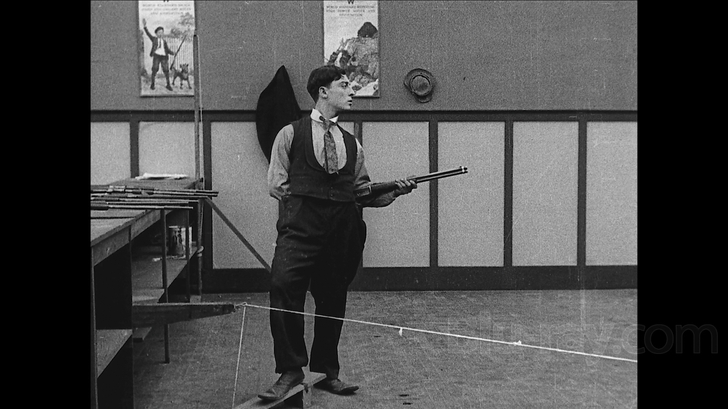
If you've seen the Buster Keaton features that Kino has previously released on Blu-ray—The General, Sherlock Holmes, Jr./Three
Ages, Steamboat Bill, Jr., and Our Hospitality—then you know exactly what to expect from the Buster Keaton Short Films
Collection. That is, transfers that are extremely faithful to their source materials, with little to no digital alteration. In varying degrees, age-related
wear and tear is present in all the shorts—vertical scratches, brightness fluctuations, mild warping, stains, and specks—and instead of trying to go
through frame-by-frame and clone out the damage, which would be time-consuming, expensive, and would certainly leave evidence of restoration,
Kino has opted to present the films as is. This, I think, is the ideal decision. Each of the films is presented with a 1080p/AVC-encoded transfer—except
One Week, which is in 1080i, presumably due to frame rate issues—and the results are beautiful. A few of the shorts, like Convict
13, Hard Luck, and The Frozen North, have been sourced from various less-than-ideal dupe and reduction prints—these show
heavier damage, less detail, and more blown out contrast—but most of the films look wonderful, with a newfound level of clarity that's often
astounding. Really, the difference between previous standard definition releases and these new HD masters is night and day. It's also clear that every
attempt has been made to keep the monochromatic gradation as balanced as possible. Blacks are usually deep—they sometimes rise up to grayish
levels when shadow detail is at stake—and whites are rarely overblown. The Haunted House and The Love Nest are also presented
with an approximation of their original color-tinted appearance. No edge enhancement is visible and film grain looks entirely natural, untouched by
noise reduction. As a kind of experiment, though, Kino has also provided "digitally enhanced" alternate versions of The High Sign, The
Boat, Cops, and The Balloonatic. Here's the disclaimer that appears before these enhanced versions:
"Generally, Kino International does not apply digital noise-reduction processes to films that show wear, as it subtly undermines the integrity of the
image. For the sake of comparison—and for those who prefer a more "polished" look—we are pleased to present this film in an alternate, digitally-
enhanced version."
"Unnatural" is probably a better word than "polished"—grain looks frozen in these versions and the image is textureless and smooth—so you'll almost
certainly want to stick with the normal editions. I'm glad these were included, though, if only so that people can do side-by-side comparisons and
realize that excessive degraining is almost always a bad idea when it comes to film restoration.
I can't say enough how pleased I am with this collection. The films look better than they ever have and perhaps ever will.
Buster Keaton: The Short Films Collection Blu-ray Movie, Audio Quality 
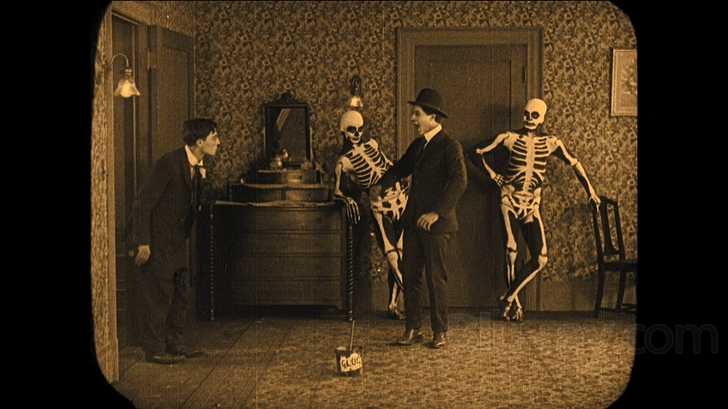
Rescoring silent films is a tricky art, but Robert Israel and Ben Model—who were commissioned to provide new music for this collection—have mastered it. The scores they deliver here are complementary rather than distracting or domineering, accentuating the action and emotion of each short. The greatest complement you could give the two composers is that their music seems like it's always been attached to these films—the recordings sound modern, with rich organ tones and no hissing, pops, or crackles, but the instrumentation itself is appropriately old-timey. There's only one score provided for each film, and although I can understand how some fans would've appreciated more audio options, the included ones are so good that there's really no room to complain. All the music is presented in uncompressed LPCM 2.0 stereo.
Buster Keaton: The Short Films Collection Blu-ray Movie, Special Features and Extras 
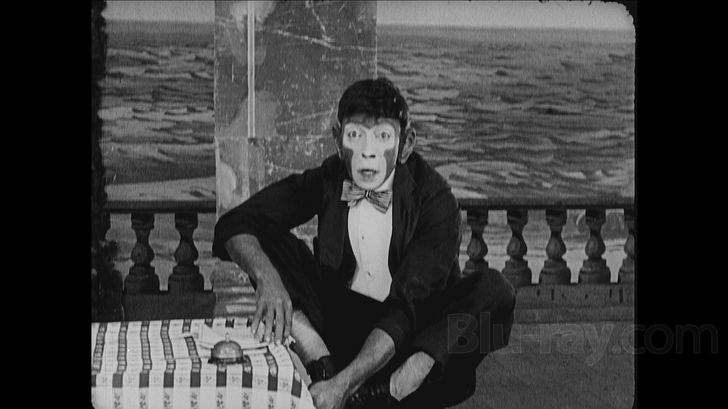
- Visual Essays (1080i): Kino International has rounded up nine Buster Keaton experts to provide "visual essays," illustrated with clips and still photographs, for 15 of the 19 short films. All told, it comes to nearly 90 minutes of informative material, including thematic analysis, behind-the-scenes anecdotes, discussion of Keaton's working methods, and more. Watching the essays after viewing the shorts will definitely contribute to your understanding of the making of the films, their context, and their lasting importance.
- The Men Who Would Be Buster (1080p): In 1929, English actor Lupino Lane basically remade The Play House, expanding on the central gag of playing all the characters himself. The result was Only Me (15:36), a two-reeler presented here in its entirety. There are also excerpts from Billy Bevan's Be Reasonable (6:35), which was influenced by The Goat, and both Charley Chase's Hello Baby! (00:53) and Stan Laurel's White Wings (00:50), which both borrowed gags from Hard Luck.
- Out-takes (1080p): Includes alternate takes, unused takes, and out-takes from The Goat (2:37), Cops (00:33), The Blacksmith (2:53), The Baloonatic (00:50), and Day Dreams (00:34).
- Tour of Filming Locations (1080i): Silent Echoes author John Bengston reveals the locations where many Keaton shorts were shot. This piece is broken into four sections, Studio (4:48), Hollywood (4:12), Civic Center (4:21), and Round-Up (3:22).
- Bonus Films (1080p): Includes Character Studies (5:33) and Seeing Stars (2:45, excerpt), two shorts that spoof Keaton and other silent film stars.
- Also From Kino (1080p, 1:10)
- Booklet: The set includes an eight-page booklet with an essay by Jeffrey Vance and notes on the individual films.
Buster Keaton: The Short Films Collection Blu-ray Movie, Overall Score and Recommendation 
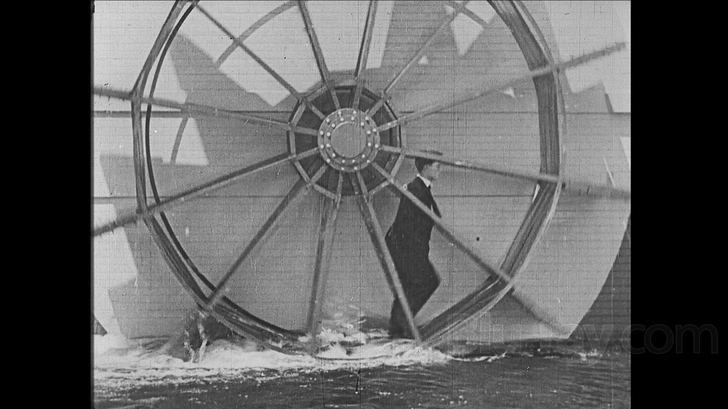
The 19 two-reelers included here chart Keaton's progression as an actor and a director, a comedic genius and a visionary who had grand plans for the future of his chosen genre. The Buster Keaton Short Films Collection, then, is a must-own for silent film fans. It's as simple as that. Kino International has put together a magnificent set, with striking high definition remasters, newly commissioned scores, and a great collection of visual essays by Buster Keaton scholars. This is definitely going to be one of my top candidates for Blu-ray release of the year. Highly, highly recommended!
Similar titles
Similar titles you might also like

Lost Keaton
1934-1937

The Saphead
Ultimate Edition
1920

Our Hospitality
Remastered
1923

College
1927

The Navigator
1924

Steamboat Bill, Jr.
1928

Seven Chances
1925

Three Ages
1923

The General
1926

The Vagabond
1916

The Immigrant
1917

Spite Marriage
included with "The Cameraman" release
1929

Modern Times
1936

The Cocoanuts
1929

A Jitney Elopement
1915

The Fireman
1916

Happy Anniversary
Heureux anniversaire
1962

What's a Nice Girl Like You Doing in a Place Like This?
included with "Scorsese Shorts" release
1963

The Count
1916

Sherlock Jr.
1924